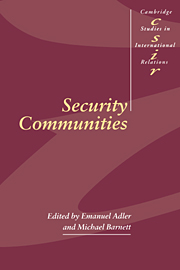Book contents
- Frontmatter
- Contents
- Notes on contributors
- Acknowledgements
- Part I Introduction and theoretical overview
- Part II Studies in security communities
- Part III Conclusions
- 12 International communities, secure or otherwise
- 13 Studying security communities in theory, comparison, and history
- Index
- CAMBRIDGE STUDIES IN INTERNATIONAL RELATIONS
13 - Studying security communities in theory, comparison, and history
Published online by Cambridge University Press: 30 October 2009
- Frontmatter
- Contents
- Notes on contributors
- Acknowledgements
- Part I Introduction and theoretical overview
- Part II Studies in security communities
- Part III Conclusions
- 12 International communities, secure or otherwise
- 13 Studying security communities in theory, comparison, and history
- Index
- CAMBRIDGE STUDIES IN INTERNATIONAL RELATIONS
Summary
Karl Deutsch and his colleagues introduced the concept of security communities in 1957, but it sat in relative theoretical anonymity and spawned few empirical studies for the next several decades. The studies that informed the seminal volume went unpublished,1 and few scholars found the concept of security communities particularly inviting against the backdrop of the Cold War, nuclear politics, and the hyperstatism and systemic theorizing that would come to define the discipline. This volume has offered the first sustained and systematic -but by no means definitive - effort to plow the twin fields of theory and history in order to dramatize the promise of the concept of security communities, and to examine regional developments through its gaze. Our goal, therefore, has been as much exploratory as exculpatory; we have been as interested in identifying the conditions under which security communities might come into existence as in providing greater empirical weight behind a revised conceptual apparatus that might prove better able to generate a rich historical and theoretical lineage.
In this concluding chapter we weave the conceptual framework with the various contributions to tease out some general propositions concerning the study of security community, to identify some shortcomings, and to consider some future avenues of research. In the first section we extend our framework by revisiting the tiers we presented in chapter 2 and refocusing energies on the concept of trust as it marks the development of a security community. To review, we were concerned with precipitating conditions, and with the dynamic relationship between process and structure.
Information
- Type
- Chapter
- Information
- Security Communities , pp. 413 - 441Publisher: Cambridge University PressPrint publication year: 1998
Accessibility standard: Unknown
- 19
- Cited by
